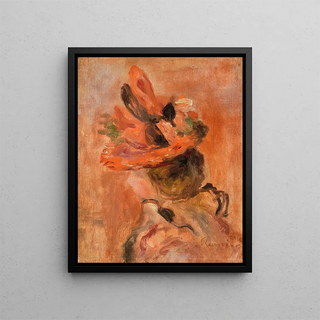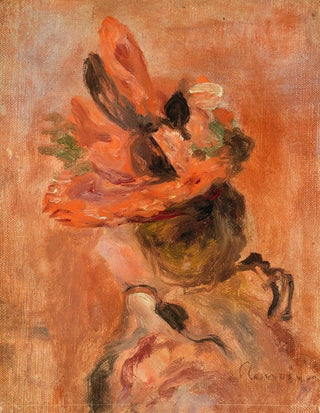Art print | Woman's head with red hat - Pierre-Auguste Renoir


View from behind

Frame (optional)
Reproduction Tête de femme avec chapeau rouge - Pierre-Auguste Renoir – Captivating introduction
In the vibrant world of Impressionism, the "Tête de femme avec chapeau rouge" by Pierre-Auguste Renoir stands out for its ability to capture the very essence of femininity and joie de vivre. Through this artwork, Renoir invites us to immerse ourselves in a fleeting moment, a pure emotion, where light and color dance together to bring a delicate figure to life. The red hat, a symbol of passion and daring, immediately draws the eye, while the woman's face, with its serene beauty, evokes an emotional depth that transcends time. This piece is not merely a portrait; it is a celebration of life, an ode to feminine beauty, capturing an era when modernity began to assert itself.
Style and uniqueness of the artwork
Renoir's style, characterized by fluid brushstrokes and shimmering colors, reveals itself in every detail of this painting. The texture of the skin, almost tangible, contrasts with the vibrancy of the hat, creating a visual harmony that captivates the eye and the heart. Renoir excels in the art of playing with light, his delicate nuances revealing the subtleties of human expressions. The composition of the piece, though seemingly simple, demonstrates rare technical mastery, where each element is carefully orchestrated to create an intimate atmosphere. The blurred background, almost impressionist, highlights the main subject, isolating the woman in a bubble of softness and warmth. This unique approach makes the "Tête de femme avec chapeau rouge" an iconic piece that remains etched in memory.
The artist and his influence
Pierre-Auguste Renoir, an emblematic figure of Impressionism, redefined the codes of painting in the 19th century. By moving away from academic conventions, he paved the way for a new way of understanding light and color. His influence is not limited to his era; it still resonates today in the work of many contemporary artists. Renoir always sought to represent beauty in all its forms, whether through portraits, landscapes, or scenes of

Matte finish

View from behind

Frame (optional)
Reproduction Tête de femme avec chapeau rouge - Pierre-Auguste Renoir – Captivating introduction
In the vibrant world of Impressionism, the "Tête de femme avec chapeau rouge" by Pierre-Auguste Renoir stands out for its ability to capture the very essence of femininity and joie de vivre. Through this artwork, Renoir invites us to immerse ourselves in a fleeting moment, a pure emotion, where light and color dance together to bring a delicate figure to life. The red hat, a symbol of passion and daring, immediately draws the eye, while the woman's face, with its serene beauty, evokes an emotional depth that transcends time. This piece is not merely a portrait; it is a celebration of life, an ode to feminine beauty, capturing an era when modernity began to assert itself.
Style and uniqueness of the artwork
Renoir's style, characterized by fluid brushstrokes and shimmering colors, reveals itself in every detail of this painting. The texture of the skin, almost tangible, contrasts with the vibrancy of the hat, creating a visual harmony that captivates the eye and the heart. Renoir excels in the art of playing with light, his delicate nuances revealing the subtleties of human expressions. The composition of the piece, though seemingly simple, demonstrates rare technical mastery, where each element is carefully orchestrated to create an intimate atmosphere. The blurred background, almost impressionist, highlights the main subject, isolating the woman in a bubble of softness and warmth. This unique approach makes the "Tête de femme avec chapeau rouge" an iconic piece that remains etched in memory.
The artist and his influence
Pierre-Auguste Renoir, an emblematic figure of Impressionism, redefined the codes of painting in the 19th century. By moving away from academic conventions, he paved the way for a new way of understanding light and color. His influence is not limited to his era; it still resonates today in the work of many contemporary artists. Renoir always sought to represent beauty in all its forms, whether through portraits, landscapes, or scenes of






